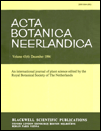Ovules and seeds of Barbeya with additional arguments for an urticalean affinity of the Barbeyaceae
F. Bouman
Hugo de Vries Laboratory, University of Amsterdam, Kruislaan 318, 1098 SM Amsterdam, The Netherlands (The Netherlands Centre for Geo-ecological Research, ICG)
Search for more papers by this authorF. D. Boesewinkel
Hugo de Vries Laboratory, University of Amsterdam, Kruislaan 318, 1098 SM Amsterdam, The Netherlands (The Netherlands Centre for Geo-ecological Research, ICG)
Search for more papers by this authorF. Bouman
Hugo de Vries Laboratory, University of Amsterdam, Kruislaan 318, 1098 SM Amsterdam, The Netherlands (The Netherlands Centre for Geo-ecological Research, ICG)
Search for more papers by this authorF. D. Boesewinkel
Hugo de Vries Laboratory, University of Amsterdam, Kruislaan 318, 1098 SM Amsterdam, The Netherlands (The Netherlands Centre for Geo-ecological Research, ICG)
Search for more papers by this authorSUMMARY
Barbeya oleoides has a bitegmic, crassinucellate and anatropous ovule. The inner and outer integuments are about five layers thick and not vascularized. The endosperm is initially nuclear, to become cellular later. The mature seed coat is unspecialized, remains parenchymatic and is locally compressed, except for the exotesta and the tanniniferous endotegmen. The exotesta is perforated by distinct crateriform holes. The embryological and anatomical seed coat characters support an urticalean affinity of the Barbeyaceae.
REFERENCES
- Boesewinkel, F.D. & Bouman, F. (1997): Ovules and seeds of Dirachma socotrana (Dirachmaceae). Plant Syst. Evol. 205: 195–204.
- Boesewinkel, F.D. & Bouman, F. (1984): The seed: structure. In: B.M Johri. (ed.) Embryology of Angiosperms, pp. 567–610. Springer-Verlag, Berlin.
10.1007/978-3-642-69302-1_12 Google Scholar
- Bouman, F. (1995): Seed structure and systematics in Dioscoreales. In: P.J. Rudall, P.J. Cribb, D.F. Cutler & C.J Humphries. (eds) Monocotyledons: systematics and evolution, pp. 139–156. Royal Botanic Gardens, Kew.
- Chernik, V.V. (1982): Peculiarities of structural development of spermoderm in some representatives of the Ulmaceae and Celtidaceae. Bot. Zurnal (Moscow & Leningrad) 67: 1216–1220 [in Russian].
- Collinson, M.E. (1989): The fossil history of the Moraceae, Urticaceae (including Cecropiaceae), and Cannabaceae. In: P.R. Crane & S Blackmore. (eds) Evolution, Systematics, and Fossil History of the Hamamelidae, vol. 2, pp. 319–339. Clarendon Press, Oxford.
- Corner, E.J.H. (1976): The Seeds of Dicotyledons, 2 vols. Cambridge University Press, Cambridge.
- Cronquist, A. (1981): An Integrated System of Classification of Flowering Plants. Columbia University Press, New York.
- Dahlgren, G. (1989): The last Dahlgrenogram. System of classification of the dicotyledons. In: K Tan. (ed.) The Davis and Hedge Festschrift, pp. 249–260. Edinburgh University Press, Edinburgh.
- Davis, G.L. (1966): Systematic Embryology of Angiosperms. Wiley, New York, London, Sydney.
- Dickison, W.C. & Sweitzer, E.M. (1970): The morphology and relationships of Barbeya oleoides. Amer. J. Bot. 57: 468–476.
- Engler, A. (1897): Ulmaceae. In: A. Engler & K Prantl. (eds) Die natürlichen Pflanzenfamilien, Nachträge Teil 3, Abt. 1, pp. 118–119. Verlag Wilhelm Engelmann, Leipzig.
- Engler, A. & Diels, L. (1936): Syllabus der Pflanzenfamilien. Gebrüder Borntraeger, Berlin.
- Friis, I. (1993): Barbeyaceae. In: K Kubitzki. (ed.) The Families and Genera of Vascular Plants, vol. 2, pp. 141–143. Springer-Verlag, Berlin.
- Hutchinson, J. (1959): Evolution and Phylogeny of Flowering Plants. Academic Press, London.
- Mabberley, D.J. (1987): The Plant Book. Cambridge University Press, Cambridge.
- Melchior, H. (1964): Ulmaceae. In: H Melchior. (ed.) A. Engler's Syllabus der Pflanzenfamilien, edn 12, vol. 2. Gebrüder Borntraeger, Berlin.
- Prakash, N., Bohm, L. & Maze, J. (1979): Development of the achene in Cannabis. Can. J. Bot. 57: 1243–1251.
- Rendle, A. B. (1916): Barbeyaceae. In: D Prain. (ed.) Flora of Tropical Africa, vol. 6.2. 1: 14. L. Reeve & Co., London.
- Schweinfurt, G. (1891): Barbeya Schwf. Gen. Nov. Urticacearum. Malpighia 5: 332–340.
- Swensen, S.M. (1996): The evolution of actinorhizal symbiosis: evidence for multiple origins of the symbiotic association Amer. J. Bot. 83: 1503–1512.
- Takaso, T. & Tobe, H. (1990): Seed coat morphology and evolution in Celtidaceae and Ulmaceae (Urticales). Bot. Mag. (Tokyo) 103: 25–41.
- Takhtajan, A. (1969): Flowering Plants. Origin and dispersal. Oliver & Boyd, Edinburgh.
- Takhtajan, A. (1980): Outline of the classification of flowering plants (Magnoliophyta). Bot. Rev. (Lancester) 46: 225–359.
- A Takhtajan. (ed.) (1992): Anatomia Seminum Comparativa, vol. 4. NAUKA, St Petersburg.
- Thorne, R.F. (1992): Classification and geography of the flowering plants. Bot. Rev. (Lancester) 58: 225–348.
- Thulin, M.B., Bremer, B., Richardson, J., Niklasson, J. & Chase, M.W. (in press): Family relationships of the enigmatic rosid genera Barbeya and Dirachma from the Horn of Africa region. Plant Syst. Evol.
- Tobe, H. & Takahashi, M. (1990): Trichome and pollen morphology of Barbeya (Barbeyaceae) and its relationships. Taxon 39: 561–567.
- Verkerke, W. (1985): Ovules and seeds of the Polygalaceae. J. Arnold Arbor. 66: 353–394.
- Watson, L. & Dallwitz, M.J. (1996): The Families of Flowering Plants: descriptions and illustrations. URL http://www.keil.ukans.edu/delta/.
- Willis, J.C. (1985): A Dictionary of the Flowering Plants & Ferns, Student edition. Cambridge University Press, Cambridge.
- M.S Yakovlev. (ed.) (1981): Comparative Embryology of Flowering Plants. Winteraceae-Juglandaceae. NAUKA, St Petersburg.




